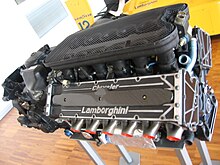In April 1987, in an acquisition spearheaded by Chrysler chairman Lee Iacocca, the American company took control of the Italian automaker, after paying out US$33 million to the Mimrans. According to Jolliffe, the Mimran brothers were the only owners of Lamborghini to ever make money out of the company, having sold it for many times the dollar amount they paid for it six years earlier.
Iacocca, who had previously orchestrated a near-miraculous turnaround of Chrysler after the company nearly fell into bankruptcy, carried out his decision to purchase Lamborghini with no challenges from the board of directors. Chrysler people were appointed to Lamborghini's board, but many of the company's key members remained in managing positions, including Alfieri, Marmiroli, Venturelli, and Ceccarani. Ubaldo Sgarzi continued in his role as head of the sales department. To begin its revival, Lamborghini received a cash injection to the tune of $50 million. The automaker's new owner was interested in entering the "extra premium" sports car market, which it estimated at about 5,000 cars per year, worldwide. Chrysler aimed to produce a car to compete with the Ferrari 328 by 1991, and also wanted the Italians to produce an engine that could be used in a Chrysler car for the American market. The decision was made to finally take the company into motorsport; the effort would be known as Lamborghini Engineering S.p.A., and would develop engines for Grand Prix teams. The new division was based in Modena, and given an initial budget of $5 million. Danielle Audetto would be the manager, and Emile Novaro the president; their first recruit was Mauro Forghieri, a man with a stellar reputation in the world of motorsport, who had formerly managed Ferrari's Formula 1 team. Forghieri set about designing a 3.5-litre V12 engine, independent of road-car engine design undertaken at Sant'Agata.
At the time, Lamborghini was working on a successor to the Countach, the Diablo. The car's original design had been penned by Marcello Gandini, the veteran who had penned the exterior appearances of the Miura and the Countach while working for coachbuilder Bertone. However, Chrysler executives, unimpressed with Gandini's work, commissioned the American car-maker's own design team to execute a third extensive redesign of the car's body, smoothing out the trademark sharp edges and corners of Gandini's original design; the Italian was left famously unimpressed with the finished product. The Diablo had been intended for release in time for September 1988, when Lamborghini would celebrate its 25th anniversary; once it was clear that mark would be missed, a final version of the Countach was rushed into production instead. The Anniversary Countach was later acclaimed as the finest version of the car to be built.
By the end of 1987, Emile Novaro had returned from his long recovery, and used his authority to halt Chrysler's increasing interference in the development of the Diablo. Much to the chagrin of the Fighting Bull, Chrysler exhibited a four-door concept car at the Frankfurt Auto Show, badged as a 'Chrysler powered by Lamborghini'. The Portofino was poorly received by the motoring press and Lamborghini's employees alike, but went on to become the inspiration for the Dodge Intrepid sedan.
In April 1988, the Bertone Genesis, a Quattrovalvole V12-powered, Lamborghini-branded vehicle resembling a minivan was debuted at the Turin motor show. The unusual car, intended to gauge public reactions, was abandoned, a misfit in both Lamborghini's and Chrysler's product ranges. The Genesis had been commissioned alongside the new "baby Lambo" that would replace the Jalpa, occupying the then-empty space below the Diablo in Lamborghini's lineup. The project had been allocated a $25 million budget, with the prospect of selling more than 2,000 cars per year.
The uptick in fortunes was to be brief; in 1992, sales crashed, as the $239,000 Diablo proved ultimately to be inaccessible to American enthusiasts. With Lamborghini bleeding money, Chrysler decided that the automaker was no longer producing enough cars to justify its investment
 |
| The Diablo was the fastest car in production when it was released in 1990. |

0 nhận xét:
Post a Comment